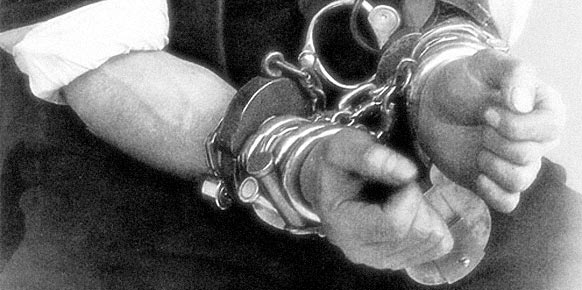Houdini's Handcuff Acts
Magicians began to demonstrate handcuff acts as early as the 1890s. According to NEW IDEAS IN MAGIC, published in 1902, the secret to a successful handcuff act is having multiple sets of keys. Having the full set of 45 keys would allow traveling magicians the most success. When entering a new town, the magician would research the handcuffs used by the local police as well as any "special" handcuffs and conceal the keys somewhere on his person. Concealing keys was simple when presenting a normal stage act as time would often not allow for an exhaustive search.
It was as "The King of Handcuffs" that Houdini first came into fame during the early years of the twentieth century. At the beginning of his career, Houdini would simply conceal the keys in secret pockets or a bag strapped to his leg. As his skills and popularity grew, Houdini invented and used a belt made of flexible steel, containing special compartments within a double wall. The inner belt ran on tiny ball bearings that could be revolved by pressure from Houdini's arm. This solved the biggest problem in handcuff work: accessibility. With this belt, Houdini could have access to any tool he required with only slight of hand.
Houdini welcomed all "freak" handcuffs, even if had no tool for unlocking them. To complete the act, Houdini would insist on trying the key, to make sure it worked. In doing so, he would allow his assistant a look at the key. This assistant would switch out the real key with a similar- looking key from Houdini's collection kept behind the stage. The assistant would pass the real key to Houdini, who would give the false key back to the handcuff's owner. He would then free himself from the difficult handcuffs, using the observer's own key. Some handcuffs, called "jumpcuffs," could be opened by simply replacing its strong interior spring with a weak spring. The handcuffs would pass inspection, but could be opened by a tug on the wrists. These were used when making a jump from a bridge into a river before large crowds. The "jumpcuffs" were pulled open immediately after hitting the water, allowing Houdini to come to the surface freed from restraint.
Another of Houdini's systems was to have his wrists locked with four or five pairs of handcuffs. The "strange" pair were placed higher up, where his forearms were much thicker than his wrists. From here, he would simply slip off the cuffs after unlocking the pairs below. Houdini also dealt with difficult handcuffs by using them as connection links, in a chain of three handcuffs. One wrist would be placed behind the neck with a handcuff attached and dangling downward. The "strange" cuffs would be linked to that; then locked to another, which in turn would be locked around the other wrist. All that was necessary was to unlock the "regular" pairs and the middle pair would fall free.







